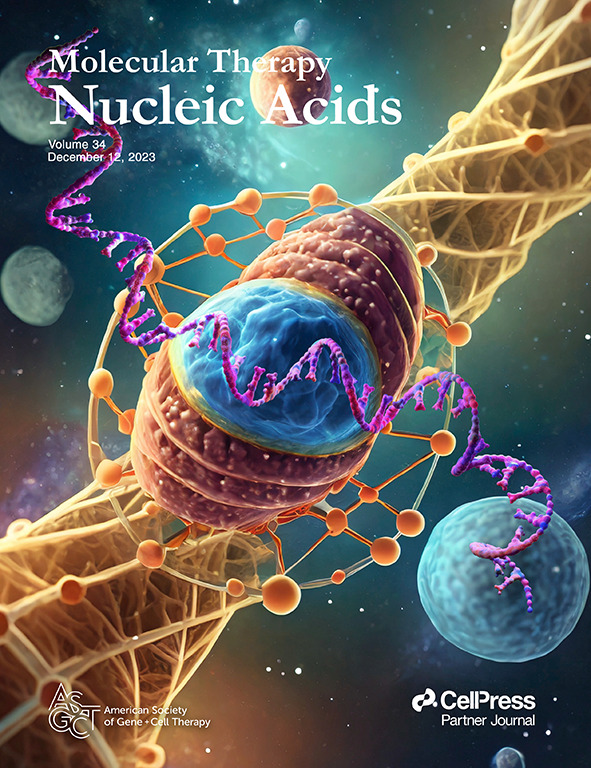2′,4′-BNA/LNA与9-(氨基乙氧基)吩嗪的反义寡核苷酸具有良好疗效并降低了急性神经毒性
IF 6.5
2区 医学
Q1 MEDICINE, RESEARCH & EXPERIMENTAL
引用次数: 0
摘要
越来越多的反义寡核苷酸(ASO)已被批准用于临床。然而,提高在中枢神经系统(CNS)中的疗效和安全性对于中枢神经系统疾病的治疗至关重要。为了解决这些关键问题,我们开发了各种间隙聚合 ASO,其中包括一种新型核苷衍生物,包括含有 9-(氨基乙氧基)吩噁嗪的 2′,4′-BNA/LNA(BNAP-AEO)。对含有 BNAP-AEO 的各种间隙聚合物 ASO 的热稳定性、药效和急性中枢神经系统毒性进行了评估。转染到神经母细胞瘤细胞系的实验表明,与不含 BNAP-AEO 的 ASOs 相比,含 BNAP-AEO 的 ASOs 具有更有效的基因沉默效应。令人惊讶的是,通过开放性现场试验和评分系统评估,含有 BNAP-AEO 的 ASOs 对小鼠急性中枢神经系统的毒性明显低于不含 BNAP-AEO 的 ASOs。这项研究强调了含有 BNAP-AEO 的 ASOs 具有高效的基因沉默效应和较低的急性中枢神经系统毒性,显示了其在未来治疗应用中的潜力。本文章由计算机程序翻译,如有差异,请以英文原文为准。
Favorable efficacy and reduced acute neurotoxicity by antisense oligonucleotides with 2′,4′-BNA/LNA with 9-(aminoethoxy)phenoxazine
An increasing number of antisense oligonucleotides (ASOs) have been approved for clinical use. However, improvements of both efficacy and safety in the central nervous system (CNS) are crucial for the treatment with CNS diseases. We aimed to overcome the crucial issues by our development of various gapmer ASOs with a novel nucleoside derivative including a 2′,4′-BNA/LNA with 9-(aminoethoxy)phenoxazine (BNAP-AEO). The various gapmer ASOs with BNAP-AEO were evaluated for thermal stability, and efficacy, and acute CNS toxicity. Thermal stability analysis of the duplexes with their complementary RNAs showed that ASOs with BNAP-AEO had a higher binding affinity than those without BNAP-AEO. assays, when transfected into neuroblastoma cell lines, demonstrated that ASOs with BNAP-AEO, had a more efficient gene silencing effect than those without BNAP-AEO. assays, involving intracerebroventricular injections into mice, revealed ASOs with BNAP-AEO potently suppressed gene expression in the brain. Surprisingly, the acute CNS toxicity in mice, as assessed through open field tests and scoring systems, was significantly lower for ASOs with BNAP-AEO than for those without BNAP-AEO. This study underscores the efficient gene-silencing effect and low acute CNS toxicity of ASOs incorporating BNAP-AEO, indicating the potential for future therapeutic applications.
求助全文
通过发布文献求助,成功后即可免费获取论文全文。
去求助
来源期刊

Molecular Therapy. Nucleic Acids
MEDICINE, RESEARCH & EXPERIMENTAL-
CiteScore
15.40
自引率
1.10%
发文量
336
审稿时长
20 weeks
期刊介绍:
Molecular Therapy Nucleic Acids is an international, open-access journal that publishes high-quality research in nucleic-acid-based therapeutics to treat and correct genetic and acquired diseases. It is the official journal of the American Society of Gene & Cell Therapy and is built upon the success of Molecular Therapy. The journal focuses on gene- and oligonucleotide-based therapies and publishes peer-reviewed research, reviews, and commentaries. Its impact factor for 2022 is 8.8. The subject areas covered include the development of therapeutics based on nucleic acids and their derivatives, vector development for RNA-based therapeutics delivery, utilization of gene-modifying agents like Zn finger nucleases and triplex-forming oligonucleotides, pre-clinical target validation, safety and efficacy studies, and clinical trials.
 求助内容:
求助内容: 应助结果提醒方式:
应助结果提醒方式:


